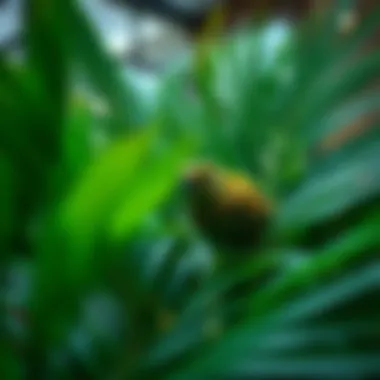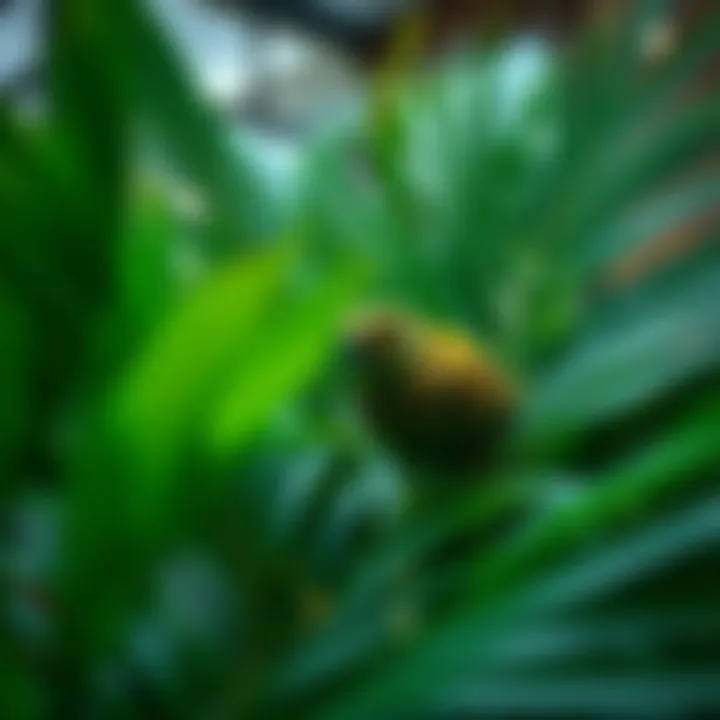Your Complete Guide to Indoor Palm Plant Care


Intro
Indoor palm plants have been a staple in homes and offices for decades, offering both aesthetic appeal and air-purifying qualities. This guide ventures into the heart of nurturing these beautiful greenery specimens, catering equally to those just stepping into the world of indoor gardening and seasoned cultivators honing their skills.
Often perceived as symbols of tropical luxury, palms like the Areca and Kentia not only elevate your interior but also contribute to a healthier living environment. Understanding their needs is pivotal for promoting lush growth and vitality. Imagine walking into your space, greeted by the fresh, vibrant foliage of a well-cared-for palm. It's not just about appearance; it's about creating a lively atmosphere that breathes.
As we traverse through this guide, we'll peel back the layers of various palm species, uncover optimal light conditions, aligned watering practices, suitable soil, pest management, and common issues. Each palm has its unique charm and challenges, and it’s this personalization in care that makes the difference.
Whether you’re looking to create a small indoor jungle or simply add a touch of green to your desk, let’s embark on this journey to ensure the palms you choose thrive, not just survive.
By the time you finish reading, you’ll possess a wealth of knowledge designed to nurture and sustain your indoor palms, enhancing both their beauty and lifespan. So, roll up your sleeves and let’s dig in.
Prelude to Indoor Palm Plants
Indoor palm plants are not just a pretty face in the world of houseplants; they are key players in creating a healthier and more pleasant living environment. Understanding how to properly care for these majestic plants is essential for both novices and experts alike. By delving into the various species, light requirements, watering practices, and more, this guide aims to equip you with the knowledge to nurture these green companions effectively.
Why Choose Palm Plants for Indoor Spaces
When it comes to houseplants, palms can be a fantastic choice for many reasons. These plants are not only visually pleasing, but they also serve practical functions. Most indoor palm varieties are relatively low-maintenance and thrive in moderate light conditions. They are effective air purifiers, making them an ideal addition to homes and offices.
Palms introduce an element of tropical elegance to any space. They can enhance aesthetics, frame your windows, or stand majestically in the corner of a room. Additionally, palms tend to be robust, adapting well to different indoor environments. They symbolize growth and serenity, which can instantly uplift the atmosphere of a room.
However, with all their beauty and benefits, it's worth remembering that proper care is essential for sustaining their health. Malnourished or overlooked palms can decline rapidly, showing signs of distress such as yellowing fronds or stunted growth. The good news? Most issues can be avoided with the right knowledge and attention.
Popular Indoor Palm Species
There’s a wide variety of indoor palm species to consider. Below are some noteworthy palms that not only look great but are also relatively easy to care for:
Areca Palm
The Areca Palm, known for its feathery fronds and graceful appearance, is one of the most popular choices among indoor enthusiasts. It's often chosen for its ability to grow tall yet remain slender, making it perfect for tight spaces. Additionally, the Areca Palm is excellent for air purification, contributing to a cleaner indoor atmosphere. Its unique characteristic of shedding old leaves naturally allows for easy maintenance. However, you should be mindful that it does require humidity to thrive, which might necessitate some extra effort in drier climates.
Bamboo Palm
Bamboo Palm is another great option, recognized for its bushy appearance and versatility. It's particularly suited for low-light situations, making it a go-to choice for darker rooms. The Bamboo Palm can grow up to several feet, providing a perfect privacy screen or decorative accent. One of its standout features is its ability to filter benzene and formaldehyde from the air. The downside, however, is its somewhat slower growth rate compared to other palms, meaning it takes a bit longer to fill out a space.
Lady Palm
The Lady Palm, with its lush green fronds, strikes a chord with many indoor gardeners. This palm is known to tolerate a variety of light conditions, though it prefers indirect sunlight. The Lady Palm can add a touch of elegance to your space with its cascading leaves. Moreover, it is quite forgiving of neglect, making it perfect for those who are still figuring out their plant care routine. On the flip side, it can be susceptible to pests like spider mites, so vigilance is key.
Kentia Palm
If you're looking for sophistication, the Kentia Palm might just be your best bet. It's graceful and can grow quite tall, often reaching heights of 10 feet indoors. It's famed for its resilience; this palm can handle a few changes in its environment without throwing a fit. One downside might be that it can be pricey, but the aesthetic rewards it offers can outweigh the cost for many plant lovers.
Parlor Palm
Finally, the Parlor Palm is a classic choice for indoor spaces. It stays compact, making it suitable for apartments or offices. Known for its easy-going nature, the Parlor Palm can thrive in a range of light conditions, although it generally prefers low light. One of its unique features is that it can tolerate lower humidity levels than some other palm species. Nonetheless, it can sometimes suffer from poor posture if its light needs aren’t adequately met, requiring some adjustments.
In summary, choosing the right palm species can significantly influence your indoor gardening experience. Each of these palms comes with its own set of advantages and potential challenges, making informed choices essential for successful care and growth.
Optimal Growing Conditions
Creating the right environment for indoor palm plants is crucial for their health and longevity. Optimal growing conditions ensure that these plants not only survive but thrive, showcasing their lush and vibrant foliage. Understanding the specific needs of palm plants helps to preempt potential issues. The major factors include light, temperature, and humidity, all interconnected and pivotal in crafting a suitable habitat.
Light Requirements for Palms
Understanding Indirect Light
Most indoor palms flourish in indirect light, an essential type of lighting that mimics natural conditions in their native habitats. This light is not direct and harsh; instead, it gets filtered or reflected, keeping the intensity at bay. The key characteristic is its ability to provide sufficient brightness without the risk of scorching the leaves. This position allows palms to bask in dappled sunlight, which promotes healthy growth while protecting their delicate fronds.
Using indirect light contributes significantly to preventing leaf burn, a common issue in plant care. One unique feature of this approach is its adaptability to various indoor settings. For instance, placing a palm near a window covered with sheer curtains or further back from a window allows for suitable light exposure without overwhelming the plant. The advantage lies in its broad applicability—perfect for homes and offices alike where direct sunlight may be scarce or too intense.
Identifying Signs of Insufficient Light
It’s vital to recognize the signs that indicate your palm isn’t receiving enough light. One telltale sign is yellowing leaves, which can start as a subtle hue before progressing to a broader canopy of troubled foliage. Another indicator is leggy growth, where the stems stretch toward light sources, causing the plant to appear lanky rather than full and robust.
The primary characteristic of recognizing insufficient light is the yellowing effect—leaves lose their lush green tone, signaling distress. This’s crucial because timely identification can help tailor light conditions swiftly, preventing further damage. The unique feature of this observation is its applicability; once identified, adjusting the lighting can be a simple yet effective method to restore vigor. The downside? If left unattended too long, palm plants can suffer long-term growth issues, stunting their development.
Temperature and Humidity Preferences
Temperature Range for Healthy Growth
Palm plants generally prefer a temperature range of 65 to 80 degrees Fahrenheit. Maintaining this temperature range is key to fostering a healthy environment. A stable climate helps minimize stress on the plants, ensuring they can effectively manage other care aspects like watering and nutrients. One of the main characteristics of achieving this temperature is the prevention of rapid fluctuations, which can lead to shock.
Moreover, palms enjoy warmth without extreme heat. Light drafts or cold air can damage them, making it important to locate them away from air conditioning vents or open windows during cold weather. The unique feature of maintaining this temperature is its simplicity; consistent attention can help develop a thriving indoor oasis.
The Role of Humidity in Palm Care
Humidity plays a vital role in the health of indoor palms. These plants naturally thrive in the humid undergrowth of tropical forests, and replicating this can yield stunning results. The key characteristic is the moisture in the air, which helps to keep leaves lush and vibrant. For palm enthusiasts, understanding ideal humidity levels—around 50% to 70%—enhances growth potential significantly.
One interesting factor to consider is that indoor heating systems can dry out the air, leading to crispy leaf tips and stunted growth. To combat this, employing a humidifier or placing water trays near plants can help increase moisture levels in the air, replicating their natural habitat. However, balancing this humidity is necessary; too much moisture can invite mold and pests, making awareness a must in the care process.
"Maintaining the right temperature and humidity can transform your indoor palm into a thriving centerpiece!"
By meeting these fundamental needs, you're setting the stage for your indoor palms to grow vigorously, turning your living space into a small slice of paradise.
Watering Techniques


Watering is an essential aspect of indoor palm plant care, often underestimated. Correct watering directly influences the health and longevity of your palms. Overwatering can lead to root rot, while underwatering may stress the plant, leading to wilting or worse. Understanding the nuances of watering techniques not only contributes to a thriving indoor environment but also helps in recognizing the individual needs of different palm species. Knowing when and how much to water will aid in keeping your palms happy and vibrant.
Determining Watering Frequency
Signs of Overwatering
Overwatering manifests in several recognizable ways, and it forms the crux of healthy palm maintenance. A key characteristic includes yellowing leaves, which can occur when roots sit in stagnant water for too long. This highlights that your watering routine might be a bit too generous. Yellowing leaves can be an eyesore, but they serve as a beneficial warning sign, prompting corrective measures before the plant's health declines further.
Another important aspect of overwatering is root rot, which can go unnoticed until it’s too late. To prevent this, it’s wise to ensure that the pot has adequate drainage holes. The unique feature of identifying overwatering is that it enables immediate action; reducing canvas on issues that may arise from excess water can save your palm from detrimental effects.
Identifying Underwatering Issues
On the flip side, identifying underwatering issues also plays a pivotal role in palm care. A prominent sign includes browning leaf tips or leaves curling up, suggesting the plant is in need of a drink. These characteristics stand out as cries for help, giving you a chance to rectify your watering practices before it's too far gone.
Underwatering issues tend to creep in insidiously, affecting the growth and overall vigor of the plant. The unique feature of this problem is that it often leads to a domino effect, disrupting the plant's resilience against pests and diseases. By keeping an eye on the moisture level in the soil and adjusting your routine accordingly, you can achieve a balance that fosters healthy growth.
Best Practices for Watering
Water Quality Considerations
The quality of water used for your palms is another crucial consideration in watering practices. Tap water, while convenient, often contains chlorine and other chemicals that may not sit well with all plants. Using filtered or rainwater can be beneficial, as households with hard water may unintentionally introduce unwanted minerals that affect growth. Choosing the right quality of water not only promotes better absorption of nutrients but also supports the plant’s overall health.
A unique aspect of water quality is that it can be a driving force in alleviating problems before they even arise. You might find your palm flourishing with just a simple switch in water source. Additionally, ensuring that the water is at room temperature can help roots absorb it more effectively and minimize shock.
Watering Methods: Top vs. Bottom Watering
Watering methods can also make a significant difference in how well your palms respond. Top watering involves pouring water directly on the soil surface, while bottom watering entails placing the pot in a dish of water, allowing the roots to absorb moisture from below. Each method has its benefits. Top watering can sometimes lead to uneven distribution of moisture, whereas bottom watering can promote deeper root growth, as roots reach down for their moisture.
Incorporating both methods into your care routine can create a balanced approach, depending on the specific needs of each palm species you might be tending to. Understanding these methods will be advantageous in fostering a supportive environment for your palms.
"Correct watering can be a game-changer in the life of your indoor palms, making the difference between a struggling plant and a vigorous one."
Remember, each palm species will have its own preferences, so it might take a bit of trial and error to find what works best. Keeping a journal or notes about your watering routine can help fine-tune this aspect of care. For guidance on specific plants, resources like Wikipedia, and Britannica offer further insights into the preferences of different palm species.
Soil and Fertilization Needs
When it comes to indoor palm plants, understanding soil and fertilization needs is crucial. The right soil supports the entire plant, ensuring roots can grow freely and receive the necessary nutrients. On the other hand, proper fertilization not only helps maintain the health of the plant but also promotes vibrant growth. It's essential to focus on these elements to nurture lush green fronds.
Choosing the Right Soil Mix
Characteristics of Ideal Palm Soil
The ideal palm soil is designed to provide excellent drainage while retaining enough moisture for the roots. A good mix typically includes organic materials such as peat moss, vermiculite, or coconut coir. Well-draining properties prevent water from pooling around the roots, which can lead to root rot.
A key characteristic of ideal palm soil is its lightweight quality. This ensures that air can circulate freely among the roots, which is vital for healthy growth. Additionally, a well-aerated soil mix helps prevent compacting, which can suffocate the roots over time. In a nutshell, choosing suitable soil means giving your palm plant a stable and supportive home.
Advantages of Ideal Soil:
- Retains moisture without waterlogging
- Provides essential aeration
- Supports root health over time
Creating a Custom Soil Blend
If you're feeling adventurous, consider creating a custom soil blend tailored specifically for your palm plants. This approach allows you to fine-tune the components based on the specific needs of your indoor palms. A custom mix can include a combination of general houseplant potting soil, perlite for drainage, and even some orchid bark for additional structure.
One unique feature of creating your own blend is the ability to adjust the texture and drainage properties precisely. This ensures an optimal balance between moisture retention and airflow, which is often crucial for palms that may suffer in overly compact soils.
The benefits of a custom soil mix are numerous but take care to maintain a balance. Failure to achieve the right consistency may result in either too much drainage or inadequate support for the roots.
Benefits of Custom Soil:
- Tailored drainage and moisture levels
- The ability to integrate specific nutrients as needed
- A deeper understanding of soil composition for future gardening projects
Fertilization Techniques for Indoor Palms
Moving on from soil, we arrive at another component of palm care: fertilization techniques. Proper fertilization contributes significantly to the overall health and vitality of your palms. The right nutrients promote not just growth but also resilience against diseases and pests.
Frequency and Type of Fertilizers
Knowing how often to fertilize is key. Generally, palm plants flourish with a steady feeding schedule during their active growing season, which typically runs from spring through summer. A balanced fertilizer with a ratio such as 3-1-2 or one specifically labeled for palms is a good choice.
Often, gardeners might point to slow-release fertilizers as a sound investment. These encourage consistent nutrient availability, helping to prevent the spikes in nutrient levels that can occur with quick-release products. However, over-fertilizing can be harmful, causing salt buildup and root damage. Therefore, it is crucial to follow the manufacturer's instructions on application rates and frequency.
Cons of Over-Fertilization:
- Possible nutrient burn
- Favoring excessive growth, compromising the plant's overall health
Signs of Nutrient Deficiencies
Recognizing the signs of nutrient deficiencies is vital for maintaining a healthy indoor palm. For instance, yellowing leaves might indicate a nitrogen deficiency, while brown tips are often a sign of potassium shortages. If your palm’s growth appears sluggish or stunted, it could be a clue that it’s lacking essential nutrients.
Monitoring your palm’s health allows for timely interventions. These signs act as an early warning system, signaling the need for adjustments in your care practices. Each nutrient deficiency has unique traits, thus learning to identify them sets the foundation for creating a lush environment for your palm plants.
Key Signs to Look For:
- Yellowing leaves
- Weak or stunted growth
- Leaf spots or discoloration
By considering these aspects, you can ensure that your indoor palms are not only surviving but thriving, creating a better living space for you and your green companions.
Pest Management Strategies


When embarking on a journey to care for indoor palm plants, understanding the realm of pests becomes crucial. These little interlopers can wreak havoc on your beloved greens, stunting growth and diminishing their aesthetic charm. Effective pest management strategies can not only safeguard your indoor oasis but also enhance the overall health and longevity of your palm plants. With the right knowledge and tools, you can keep these nuisances at bay, ensuring your plants thrive in a pest-free environment.
Common Pests Affecting Palms
Indoor palms, while beautiful, can attract a variety of pests. Awareness of these nuisances is half the battle in maintaining plant health.
Spider Mites
Spider mites are tiny, almost microscopic pests known for their web-spinning antics. Despite their size, these critters can cause a world of trouble. They thrive in dry conditions, siphoning nutrients from the leaves and often leading to a dusty appearance as they feed.
One unique feature of spider mites is their rapid reproduction rate; a few can quickly turn into a full-blown infestation. The key characteristic that makes them particularly troublesome for indoor palms is how they hide on the undersides of leaves, making them difficult to spot until the damage is done.
Advantages/Disadvantages:
While they are not as discernible as other pests, identifying them early can lead to effective treatment options and recovery. However, ignoring them may lead to significant leaf loss and overall plant decline.
Mealybugs
Mealybugs are another pest that can munch away on your palm plants. These little critters can often be seen clustered at leaf joints, looking like tiny cotton balls. They feed on the plant's sap, resulting in stunted growth and yellowing leaves.
The most significant concern with mealybugs is their ability to excrete a sticky substance known as honeydew, which can attract sooty mold. This can overshadow the aesthetics of your palm and inhibit photosynthesis.
Advantages/Disadvantages:
Although not as sleek as spider mites, mealybugs are easier to identify and remove due to their distinctive appearance. Knowing how to treat them promptly can save your plants from considerable distress.
Scale Insects
Scale insects present a heavier armor, both literally and figuratively. These pests resemble little bumps on the surface of leaves and stems. They have unique waxy coverings that guard them from many treatments.
What makes scale insects particularly damaging is that they can cause extensive damage by extracting sap. This often leads to wilting leaves or even branch dieback, all of which compromise the plant's vitality.
Advantages/Disadvantages:
Like mealybugs, recognizing scale insects can be tricky due to their inconspicuous nature. However, once identified, there are targeted therapies available to control them effectively.
Prevention and Treatment Options
Getting ahead of pest problems is the name of the game. A mix of proactive measures and timely responses can keep your palms healthy.
Natural Pest Control Methods
Many plant enthusiasts prefer using natural pest control methods as they promote a healthier environment for both plants and humans. Techniques such as introducing beneficial insects like ladybugs can help in natural pest eradication.
Another favored approach is using insecticidal soaps, which are effective against a range of pests, including mealybugs and spider mites, while being less harmful to beneficial insects.
Advantages/Disadvantages:
Natural methods require patience as they can be slower in effect. However, they enhance the ecological balance in your indoor space. The downside may be the inconsistency in results, which could pose risks if an infestation is too severe.
Chemical Treatments: Usage Guidelines
Chemical treatments, while sometimes necessary, should be used with caution. Knowing when and how to apply these chemicals is crucial for minimizing harm to your plants and the indoor environment.
Systemic insecticides can be particularly effective against scale and mealybugs, as they enter the plant’s system and provide prolonged protection. However, it’s essential to follow the application guidelines closely and always perform a spot test when trying a new product.
Advantages/Disadvantages:
The immediate action of chemical treatments can significantly reduce pest populations. However, they can also lead to pesticide resistance, so moderation is key. Balancing between natural and chemical strategies will yield the best outcomes for your indoor palms.
"Keeping an eye on your indoor palms and acting wisely against pests can make all the difference in their health."
For further reading on indoor plant care and pest management, you may find useful information at Wikipedia, Britannica or visit forums like Reddit where plant lovers share their experiences.
Common Issues and Solutions
Caring for indoor palm plants is both rewarding and challenging. Like any other living being, these plants can exhibit stress due to a myriad of factors. Addressing common issues not only helps promote healthy growth but also ensures that your greens remain a vibrant part of your living space. Understanding the stress signs and having preventative measures in place can save you from an unnecessary trip to the plant shop or, worse, losing a species you’ve grown fond of.
Identifying Stress Signs in Palms
Yellowing Leaves
Yellowing leaves can be a clear indicator that something's amiss in the life of your indoor palm. Often, this is not just a cosmetic issue; the yellowing suggests underlying problems, usually linked to improper watering practices or nutrient deficiencies. The characteristic yellowing on the fronds can evolved from a slight hue to a full-blown yellow, sometimes accompanied by dropping leaves. This makes it a significant focus area for anyone seeking to elevate their palm care game.
A unique feature of yellowing leaves is their tendency to present before the damage is severe, acting almost as a warning signal. The advantage here lies in the opportunity for early intervention. However, if ignored, it can lead to further distress and plant decline.
Brown Tips
Brown tips on palm leaves signal dehydration, nutrient shortages, or light stress. It’s almost like your palm is waving a little white flag, pleading for a bit more attention. The edges tend to turn crispy brown, making the leaves appear unhealthy and less vibrant. This can be frustrating for a proud plant parent, as it often happens unexpectedly.
These brown tips present a straightforward yet critical sign that should not go unnoticed. Their appearance can prompt the palm owner to investigate options like adjusting environmental conditions or ensuring consistent watering practices. However, one must be careful; these signs can sometimes be mistaken for too much humidity, leading to over-correction.
Stunted Growth
Stunted growth is a more serious sign and can be a red flag that your palm is struggling to thrive. When growth slows or halts altogether, it’s time to look into the potential stressors affecting your plant. This could stem from inadequate light exposure, soil compaction, or poor nutrient availability. Palms that should grow lush and tall may seem to become stagnant, which can be a source of frustration.
The good part about recognizing stunted growth in its early stages is that it indicates the potential for recovery with the right changes to care routines. Still, stunted growth may indicate more fundamental issues that need addressing, such as root health or improper feeding.
Remedies for Common Problems
Adjusting Watering Practices
One of the core solutions to many common problems is the adjustment of watering practices. Over-watering is a cardinal sin in the palm-keeping handbook, while under-watering can be just as harmful. Being aware of how much and how often to water can mean the difference between a flourishing plant and a struggling one. For instance, allowing the soil to slightly dry out between watering can prevent waterlogging, which might lead to root rot.
Moreover, if a plant is consistently showing signs of distress, like yellowing leaves or brown tips, reevaluating watering schedules could provide instant improvements. While a plant’s needs might change seasonally, having a flexible approach allows for better adaptability to its changing conditions.
Reevaluating Light Conditions


Light is another fundamental aspect of growth that often gets sidelined. Many indoor palms require bright, indirect light, and if they don't get enough, they might express their discomfort through various stress signals. Reevaluating the light conditions by perhaps moving the plant closer to a window or altering curtains can significantly improve their health.
The unique aspect of light conditions is that they can change quickly with seasons or room arrangements. This adaptability can save your palm from unnecessary stress if promptly addressed. Keeping a keen eye on these changes will not only aid in rectifying issues but also enhance your understanding of the plant's needs.
Consistent attention to stress signs and prompt remedies can create a nurturing environment that fosters growth, beauty, and longevity in your indoor palm plants.
For more insights, visit Wikipedia on Indoor Plants.
Propagation Techniques
Propagation is an essential aspect of caring for indoor palm plants as it allows enthusiasts to expand their collection or share plants with friends and family. Manually propagating palms can be quite rewarding, offering a deeper connection to these lush beauties. Not only does it enhance your personal environment, but it also promotes sustainability by reducing reliance on commercially-grown plants, which often come at a high cost.
When it comes to propagation, two common methods are seed propagation and the division method. Each method has its own set of advantages and challenges, making it crucial to understand their implications.
Methods of Propagating Palm Plants
Seed Propagation
Seed propagation involves starting new palm plants from seeds harvested from an existing plant. This method can be quite fulfilling but requires patience and attention. One key characteristic of seed propagation is its potential for genetic diversity. Each new plant shares traits from its parent, resulting in unique variations. This is a popular choice for enthusiasts looking to breed specific qualities, like leaf patterns and growth rates.
A unique feature of seed propagation is the timeline; it can take several months, and sometimes years, for seeds to germinate and grow into mature plants. The long wait can be a downside for some, but for many, it's all part of the thrill.
Advantages of Seed Propagation:
- Potential for diverse characteristics and traits.
- Ability to cultivate rare or difficult-to-find species.
Disadvantages of Seed Propagation:
- Longer waiting period for results.
- Higher possibility of seedling failure due to various factors like soil quality or temperature.
Division Method
The division method entails separating a mature palm plant into smaller sections, each capable of growing into a new, complete plant. This is often seen as a more straightforward and faster technique. One of the key characteristics that make division popular is the instantly available plant; once divided, these sections can thrive relatively quickly given the right conditions.
A unique feature of the division method is that it usually ensures the new plants possess the same genetic makeup as the parent, leading to consistency in desired traits. This aspect can be especially useful for those who have specific characteristics they wish to maintain.
Advantages of Division Method:
- Rapid results compared to seed propagation.
- Consistency in traits, making it easier to predict growth patterns.
Disadvantages of Division Method:
- Limited to already established plants, which may restrict availability for beginners.
- Potential stress to the parent plant if not managed carefully.
Best Practices for Successful Propagation
To achieve success in propagation, timing and the conditions under which you propagate are critical.
Timing and Seasonality Considerations
Timing plays a pivotal role in the success of plant propagation, particularly when it comes to indoor palms. Most palms thrive during the growing seasons of spring and summer, which are ideal for both methods of propagation. A key characteristic of good timing is that it aligns the process with the plant’s natural growth rhythms, enhancing survival rates.
Why Timing Matters:
- Helps in optimizing growth conditions, reducing stress on the plant.
- Ensures the young plants have enough light and warmth to flourish.
Creating Optimal Conditions for Growth
After determining the right time to propagate, creating optimal conditions is the next step. Environment plays a vital role; factors like humidity, light, and temperature can make or break your propagation efforts. A warm, humid environment mimics the tropical conditions that many palms are used to. This approach encourages faster root development and healthier seedlings.
Key Conditions to Optimize:
- Maintain high humidity levels around the new plants using misting or humidity trays.
- Use well-draining soil and pots that allow for adequate drainage.
"By understanding the importance of propagation techniques, you set the stage for a lush, thriving indoor palm garden. Each method opens doors to unique opportunities and challenges, inviting plant enthusiasts to deepen their connection with these remarkable specimens."
For further learning on palm cultivation and propagation, consider visiting resources like Wikipedia and Britannica.
Propagating indoor palm plants can enriching not just your plant collection but also your appreciation for the art of gardening. Make sure to assess your conditions and choose the best method that aligns with your goals.
Seasonal Care Adjustments
Caring for indoor palm plants is not a one-size-fits-all endeavor. The changing seasons necessitate different approaches to keep these tropical beauties thriving. Seasonal care adjustments are crucial because they address the shifts in light, temperature, and humidity that directly affect your plants. As the weather fluctuates, so too should your methods of care to ensure that the palms flourish in their indoor environments. This not only helps to maintain the health of the palm but also enhances its growth potential.
Adapting Care Through Seasonal Changes
Winter Care Techniques
During winter months, palm plants often experience a significant drop in light and humidity. Adjusting care to meet these conditions can be crucial. One effective winter care technique involves increasing humidity around the plant. This can be achieved by grouping several palms together or occasionally misting them. Higher humidity levels reduce the risk of brown tips and leaf drop, conditions common in indoor palm plants during dry winter months.
Another factor to consider is reducing watering frequency. As temperatures cool down, the metabolism of the plant also slows. This means the palms need less water. A common mistake is overwatering during winter. By allowing the soil to dry out slightly between watering, you can prevent root rot and other issues.
A unique feature of winter care techniques is the emphasis on providing protective barriers. Doing this can shield the plants from drafts that can occur in colder months. Using plant covers or placing them away from windows will help keep their environment stable. However, one disadvantage might be that it can make it a bit inconvenient to monitor their conditions closely.
Preparing for Summer Heat
As summer rolls around, palm plants require care that addresses higher temperatures and increased light intensity. One critical aspect of preparing for summer heat is ensuring that your palms receive adequate water. The higher temperatures can cause soil to dry out quickly, leading to underwatering risks. Adopting a more regular watering schedule can be beneficial during these months. Keeping the soil consistently moist will ensure the plant remains hydrated, however, caution is necessary to avoid overwatering, as well.
Another key characteristic of preparing for summer heat is adjusting light conditions. While palms appreciate bright, indirect sunlight, direct sun can scorch their leaves. Positioning your palms strategically—such as moving them a few feet away from a south-facing window—can prevent sunburn.
On the downside, the challenge during the hot weather is maintaining humidity levels since indoor air can become dry from air conditioning. Investing in a humidifier nearby or simply grouping plants can make a significant difference in helping them cope. The unique blending of techniques to achieve optimal conditions is what makes summer care particularly crucial.
Adjusting palm care for each season ensures healthy growth and longevity. By attuning to seasonal changes, you nurture a flourishing ecosystem in your home.
Ultimately, understanding seasonal care adjustments for indoor palms enables plant owners to tailor their efforts and maximize plant vitality. Knowing how to adapt to the environment's changes can lead to beautiful and healthy palm plants that enhance one’s living space.







